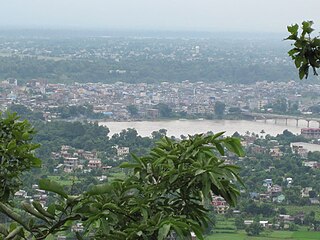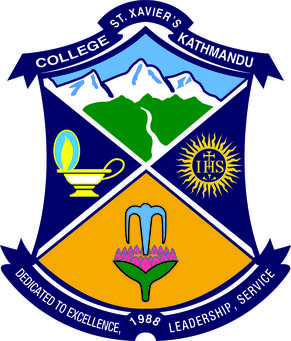
Pokhara University was established in 1997 and is Nepal's fifth university. Its central office is located in Pokhara, Kaski District, Gandaki Province. Along with Purbanchal University, PU was formed as part of a government initiative to improve access to higher education. The Prime Minister of Nepal is the university chancellor and the Minister of Education is the pro-chancellor. The vice chancellor is the principal administrator of the university.

Purbanchal University (PU) is a public university located in Koshi Province, Nepal. It was established in 1993 as the second university in Nepal after the restoration of multi-party democracy by the Government of Nepal. With more than 26,128 students, Purbanchal University stands as the second largest university in Nepal.

Chitwan District is one of 77 districts of Nepal, and takes up the southwestern corner of Bagmati Province. Bharatpur, largest city of Nepal after Kathmandu, is its administrative centre. It covers 2,238.39 km2 (864.25 sq mi), and in 2011 had a population of 579,984 people. Bharatpur is the commercial and service centre of South Central Nepal and a major destination for higher education, health care and transportation in the region. Chitwan lies in the Terai region of Nepal. It is in the drainage basin of the Gandaki River and is roughly triangular, taking that river as its meandering northwestern border, and a modest watershed border, with India, as the basis of its southern limit. Local government: Bharatpur Metropolitan, Rapti Municipality, Ratnanagar Municipality, Kalika Municipality, Khairahani Municipality, Madi Municipality, Ikshyakamana Gaupalika

Education in Nepal has been modeled on the Indian system, which is in turn the legacy of the old British Raj. The National Examinations Board (NEB) supervises all standardized tests. The Ministry of Education is responsible for managing educational activities in Nepal. The National Center for Educational Development (NCED) is Nepal's teacher-training body.
The Laguna College, more popularly known by its initials LC, is a private, nonsectarian, co-educational institution located in San Pablo City, Laguna, Philippines. It offers elementary, junior high school, senior high school, college, graduate studies.

Prime College is an information technology, management, and science college in Nayabazar (Khusibu) Kathmandu, Nepal, established in 2001. The college offers courses for BBA, BIM, BBS B.Sc. (CSIT) and CCNA.

St. Xavier's College, Maitighar is a private, Jesuit, co-educational secondary and tertiary educational institution run by the Nepal Region of the Society of Jesus in Kathmandu, Nepal. It was founded by the Jesuits in 1988 AD. Since its very inception the college has been offering quality education and has contributed to the development of the nation through the production of highly qualified human resources.

Khwopa College of Engineering is a community based engineering college established in 2001 by people of Bhaktapur with aim to provide quality education to general people with affordable fee. It has been undertaken by Bhaktapur Municipality, a local government of Nepal, since its establishment.

Triyuga is one of the eight municipalities of Udayapur district of the Koshi Pradesh of Nepal. Gaighat is the headquarter of the municipality. According to the 2021 Nepal census the total population of the municipality is 103,475. It is divided into 16 wards. Triyuga Municipality was established on B.S. Chaitra 13, 2053. It was named after Triyuga River. A river which flows through the town. Triyuga is the 3rd largest municipality in Nepal and 1st largest in Koshi Pradesh in term of size (area). The total area of the municipality is 547.43 square kilometres (211.36 sq mi)

Prithvi Narayan Campus or P.N. Campus,(Nepali: पृथ्वीनारायण क्याम्पस) is a public co-educational institution located in the northern part of the Pokhara city and is one of the largest campuses affiliated to the TU. The institution offers undergraduate(Bachelors) and graduate programmes. It is named after the great king; Prithvi Narayan Shah.
The National School of Sciences (NSS) formerly known as the National Institute of Science and Technology (NIST), was established in 1993. It is located in Lainchour, Kathmandu, Nepal. The patron of the institute is Madhav Prasad Baral, who is also the academic in charge and similarly vice principal is Pranita Sharma Baral.The school offers science and management courses, primarily focusing on science. The institute is a part of a larger NIST Foundation which has multiple other branches which offer education from the secondary level up to the graduate levels.

'National Examinations Board is the board that organizes the Higher Secondary examination and education in Nepal. It is transformed from previous Higher Secondary Education Board (HSEB) according to the Education Act of 2073 B.S. It is located in Sanothimi, Bhaktapur. The Board is the main body that organizes board exams, with the main aim of preparing skilled human resources for the development of the country.

Rajbiraj Model Higher Secondary School (RMHS) or Rajbiraj Model Campus is an educational institution in Rajbiraj, Nepal. The college is established in 2001. The college is affiliated by Higher Secondary Education Board (HSEB), Nepal for 10+2 course and Tribhuvan University for Bachelor and Masters level courses. It is the oldest private college established in Rajbiraj Municipality. The school has around 1000 students. It is situated in heart of Rajbiraj Municipality.

Balkumari College is an educational institution of higher learning, located in Narayangarh, Chitwan, Nepal. It was established on 18 September 1986. Balkumari College is affiliated to Tribhuwan University for bachelor's degree and to NEB for 11 and 12 grade.
Orchid International College , commonly known as (OIC), is an Information Technology (IT), Management college in Nepal. It was established in the year 2010 AD.The college is located at Bijayachwok-Gaushala, Kathmandu. The college currently offers Information technology, Management and Social Work courses at the Bachelor's levels. It is affiliated with the Tribhuvan University.
Janapriya Multiple Campus (JMC) is a multi-disciplinary institute affiliated to the Tribhuwan University and located in Pokhara, Nepal. The campus was established in 1991 as a non-profit academic institution to develop skilled human resources. The campus has been QAA certified by the University Grants Commission (Nepal). As of 2019, the campus has 4550 students. The campus has an arrangement with a local bank to provide employment to a few students with highest scores. The campus publishes its own academic journal annually titled Janapriya Journal of Interdisciplinary Studies.

Radiant Secondary School is a secondary school located in the area of Katan, Bhimdatta / Mahendranagar, Mahakali, Kanchanpur District of Nepal. It lies in Mahakali Zone of Nepal. It lies in the Far-Western Development Region, Nepal. It is an educational institute that offers Basic Level and Secondary Level education to the students. Every year about 1300 students attend entrance exams to study in this school, but only about 50% i.e. about 600 students only qualify. It offers intermediate education on science and management streams. It allows students to study other subjects in Grade XII as non-credit subjects. It is affiliated to National Examination Board (Nepal), previously known as Higher Secondary Education Board of Nepal. Almost every teaching staff have graduated from the international level. As per the analysis of Prasnauttar, it has been placed in the First best college in Sudurpashchim Province(also known as Provine No. 7 in Nepal) of Nepal. The official website of the college is now on internet from where student can get regular activities of school.
Sukuna Multiple Campus is a QAA Accredited community-based campus with affiliated to Tribhuvan University. It is situated at Sundar Haraincha Municipality-12, Morang, Nepal. It was established in 2048 B.S.

Ram Narayan Ayodhya Higher Secondary School is the higher secondary school in Pipara Rural Municipality of Mahottari district in Nepal. It is located in the outskirts of Pipara village of Mahottari district in Nepal. It provides education up to junior college level in Management, Science, and Education streams. It is affiliated with National Examination Board (NEB) of Nepal. It is a government higher secondary school in Nepal. The new building of the school was built with the help of Indian Embassy in Nepal. Indian Consul General Gururaj Rao laid the foundation stone of the new building of the school on 23 November 2006. This school comes under Indo-Nepal Friendship Corporation. It is one of the important school in the region. The motto of the school is "From darkness lead me to light". The founder of the school was Ram Narayan Mishra. He was the former Minister for Industry and Commerce in the Royal government of Nepal in King Mahendra regime. He took his office of Ministry on 27 May 1959.
Dhamaura Higher Secondary School also known as Janata Rastriya Secondary School, is the higher secondary school in Dhamaura village run by the Ministry of Education, Government of Nepal. It is located in Balawa Municipality of Mahottari district and provides education for more than 1800 students mainly from Dalit, Janajati, Adiwasi community.It runs education programs in the streams of Science, Management, and Education, as well as diploma courses. It is affiliated with National Examination Board (NEB) of Nepal.














